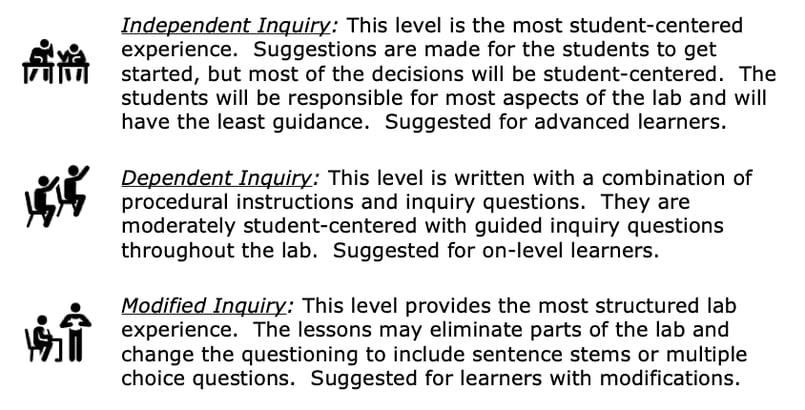Food Chemistry Inquiry Lab
Middle School Inquiry Lab on Food Chemistry
In this lab students will create a 2D model of one of their favorite foods to describe a simplified version of what happens in our bodies to the food we eat in order to release energy to support growth.
Each inquiry lab will contain an essential question that will drive the lesson and make students think. For this lesson, the essential question is:
- When we eat food, what happens to it inside our bodies?
BACKGROUND INFORMATION AND MATERIALS LIST:
Students will begin the lab by reading the essential question and background information. This can be done individually, as lab groups, or as a whole class. If you consider lab groups, you also might include some type of whole class formative checks before digging into the lab.

Materials List:
- colored pencils
- scissors
- glue or tape
- 1 “Breathe in Oxygen” page
- 1 meal page per group
- 1 model page per group
PROCEDURE:
For this lab, students will complete three tasks related to what happens to food inside our bodies after we eat it. The first activity has students setting up their food page by color-coding the items listed and filling in the key on the model page.
Secondly, students will model the process of cellular respiration, seeing how oxygen plays a vital role in the rearrangement of glucose molecules as food is broken down into energy. Students will take carbon dioxide and water molecules and model how they leave the body.
Finally, students will take the remaining parts of their food page and will model how protein, calcium, and fat all play a role in keeping our bodies healthy. It is very important to build both bone and muscle tissue, so students can see just how much of what they eat goes to support these and what left is removed as waste.
Students tend not to think about the overall affect the food they eat might have on their body’s health. This lab will enlighten students into considering a “healthier” option of food in order to build more bone and muscle tissue.
CHECK FOR UNDERSTANDING:
At this point in the lab, students will be checked for understanding by answering questions about their findings. Here are a few that come with the lab:
- In your model, why do we need to breathe in oxygen?
- For this model, you used scissors and glue to rearrange food to form new molecules. In the body, what process does this job?
CONCLUSION
Students will go back to the essential question and write a CER (Claim, Evidence, Reasoning) to conclude the lab. Once completed, students will reflect back on their learning by answering the following question:
- Your model helped you demonstrate the chemical processes your body goes through to give you nutrients. How do you know those reactions are taking place, even if you can’t see them?
MODIFIED AND INDEPENDENT INQUIRY VERSIONS
All of the Kesler Science inquiry labs come with three different modification levels. Each lab is differentiated using the icons below.
STANDARDS ALIGNMENT
NGSS: MS-LS1-7 – Develop a model to describe how food is rearranged through chemical reactions forming new molecules that support growth and/or release energy as this matter moves through an organism.

Download Over $100 in FREE Resources
For Middle School Science
Simply create a login below and gain immediate access to a selection of our Kesler Science product line worth $100 - for FREE. There's a full version of every product type! You'll also join tens of thousands of middle school science teachers who receive timely tips and strategies straight to their inbox.






